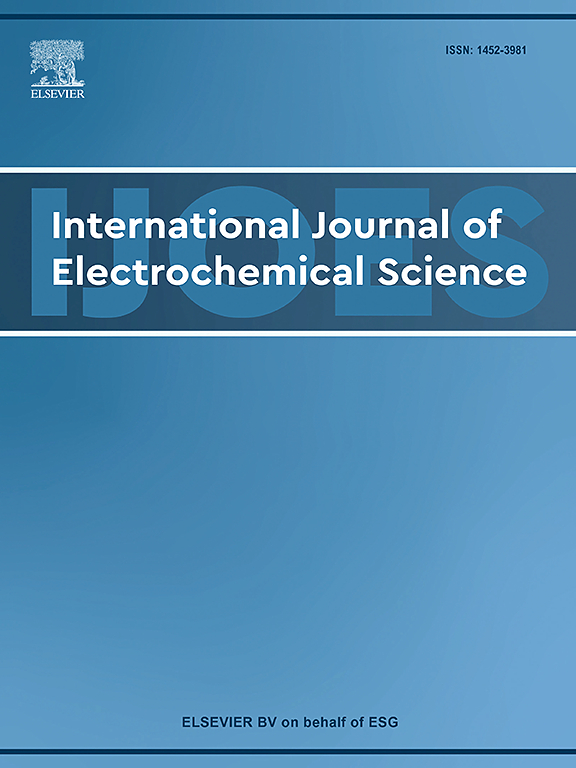Application of nano-alumina electrodes in electrochemical sensing for monitoring exercise-induced lactate
IF 2.4
4区 化学
Q4 ELECTROCHEMISTRY
International Journal of Electrochemical Science
Pub Date : 2025-07-05
DOI:10.1016/j.ijoes.2025.101124
引用次数: 0
Abstract
This study reports the development of a novel potentiometric biosensor for non-invasive analysis of lactate in human sweat, employing a carbon paste electrode modified with nano-Al2O3 and lactate oxidase (LOx). Nano-Al2O3 was synthesized via a sol–gel process, yielding uniformly dispersed, porous particles with diameters of 80–90 nm and an average crystallite size of approximately 55 nm, which enhanced the electrode’s catalytic efficiency and electron transfer capabilities. The carbon paste electrode was prepared by incorporating 10 wt% of nano-Al2O3 into a composite of graphite and carbon black, followed by immobilization of LOx from a 2.5 mg/mL solution to ensure stable enzyme activity. Electrochemical evaluation revealed that the modification reduced the charge transfer resistance from 410 Ω for the bare electrode to 324 Ω, while the subsequent enzyme coating increased resistance moderately to 534 Ω without compromising performance. Calibration studies using lactate concentrations ranging from 0.1 mM to 50 mM yielded a linear response with a sensitivity of 150 mV per decade and a detection limit of 0.08 mM. The biosensor reached stable readings within 45–60 s and exhibited high reproducibility with a relative standard deviation below 4 % over repeated tests. Ex vivo sweat analysis during controlled exercise demonstrated a recovery rate of 96 % and a strong correlation (R2 = 0.97) with standard HPLC measurements, verifying the biosensor’s real-world applicability. These results indicate that nano-scale modification via nano-Al2O3 integration significantly enhances biosensor performance, offering a promising platform for continuous metabolic monitoring in sports and clinical diagnostics.
纳米氧化铝电极在电化学传感监测运动性乳酸的应用
本研究报告了一种新型的电位生物传感器的发展,用于无创分析人体汗液中的乳酸,该传感器采用纳米al2o3和乳酸氧化酶(LOx)修饰的碳膏电极。采用溶胶-凝胶法制备了纳米al2o3,制备出粒径为80-90 nm、平均晶粒尺寸约为55 nm的均匀分散多孔颗粒,提高了电极的催化效率和电子转移能力。将10 wt%的纳米al2o3加入到石墨和炭黑的复合材料中,然后将2.5 mg/mL溶液中的LOx固定,以确保稳定的酶活性,从而制备出碳糊电极。电化学评价表明,修饰后的电极将电荷转移电阻从410 Ω降低到324 Ω,而随后的酶包覆将电阻适度提高到534 Ω,但不影响性能。使用乳酸浓度范围为0.1 mM至50 mM的校准研究产生了线性响应,灵敏度为每十年150 mV,检测限为0.08 mM。该生物传感器在45-60 s内达到稳定读数,并且在重复测试中具有高重复性,相对标准偏差低于4 %。控制运动时的体外汗液分析显示,回收率为96 %,与标准HPLC测量结果具有很强的相关性(R2 = 0.97),验证了该生物传感器在现实世界中的适用性。这些结果表明,通过纳米- al2o3集成的纳米级修饰显著提高了生物传感器的性能,为运动和临床诊断中的连续代谢监测提供了一个有前途的平台。
本文章由计算机程序翻译,如有差异,请以英文原文为准。
求助全文
约1分钟内获得全文
求助全文
来源期刊
CiteScore
3.00
自引率
20.00%
发文量
714
审稿时长
2.6 months
期刊介绍:
International Journal of Electrochemical Science is a peer-reviewed, open access journal that publishes original research articles, short communications as well as review articles in all areas of electrochemistry: Scope - Theoretical and Computational Electrochemistry - Processes on Electrodes - Electroanalytical Chemistry and Sensor Science - Corrosion - Electrochemical Energy Conversion and Storage - Electrochemical Engineering - Coatings - Electrochemical Synthesis - Bioelectrochemistry - Molecular Electrochemistry

 求助内容:
求助内容: 应助结果提醒方式:
应助结果提醒方式:


